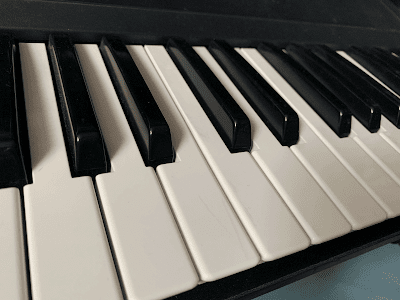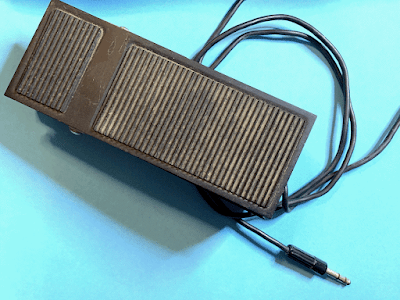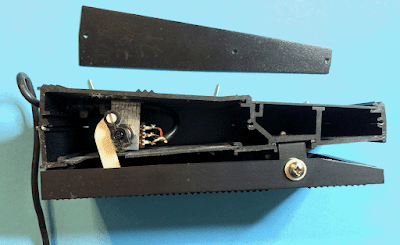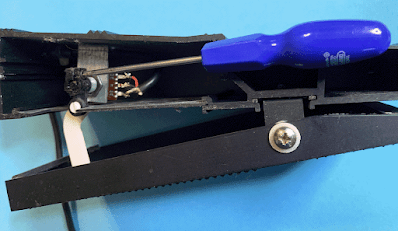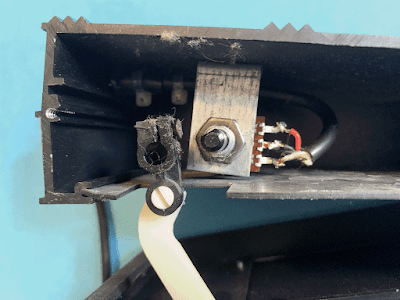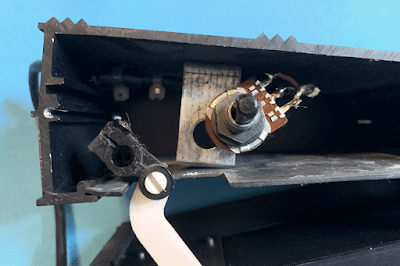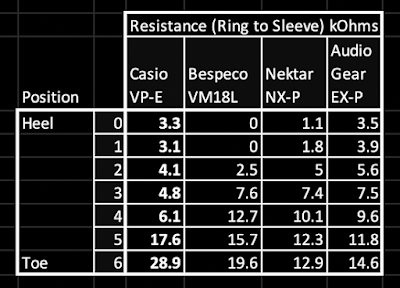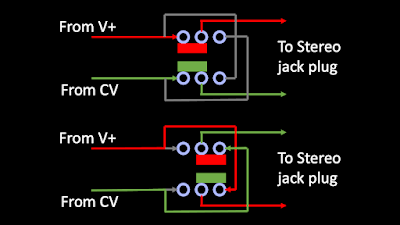Now if this was a YouTube channel, then I might well be posting videos with click-bait titles in an ongoing quest for subscribers (or publicising an amazing device like the Rebel Technology 'Witch'!).
But this is a blog, and I'm happy to post anything I do, that might be useful, which is why there's an eclectic mix of topics on here. And yes, I know that I haven't covered MaxForLive for a while, and there's a very good reason for that.
Anyway, here's a little bit of fun that might be useful to some of you, or could serve as inspiration for further exploration. I'm almost tempted to post a version on YouTube with a Click-Bait-oriented title just to see what happens... 'Expression Sequencing - What you need to know!'
 |
| Photo by Steve Harvey on Unsplash |
Step Sequencing
Okay, I admit, I've been a fan of step sequencers since seeing Tangerine Dream back in the 70s at the Liverpool Empire. Dry ice clouds, mist curtains, mirror balls, CO2 lasers, guitar solos from Edgar Froese and just one or two step sequences - it was quite an experience. Since then, I have acquired a few hardware step sequencers (a Zaquencer, for instance - very nice!), and programmed a few (several in MaxForLive, for example), but my latest acquisition is a little bit different: a mix of old school (8 steps!) and new-ish school (MIDI Clock sync!). But not a Eurorack module - nope, this is a 'guitar' pedal.
Now, I was raised on Electro-Harmonix pedals (I always wanted an Electric Mistress Flanger!) and I've gradually been getting a few modern examples, purely for research purposes, you understand. The 'pedal' in this case is on the borders of the pedal-world - it is the 8 Step Program: a CV/Expression sequencer.
Sequencers in pedals are quite unusual, or at least, from my limited viewpoint, that seems to be the case. The Strymon 'Night Sky' has a sequencer to ty and liven up the shimmer reverb, is one example, and I'm not immediately familiar with any other examples. Of course, with thousands of pedal manufacturers and hundreds of pedals released every month (week? day? hour? minute?), then there could well be many other examples, but I'm beginning to think that it is not humanly possible to keep up with pedal releases any longer. Although, if anyone can, it would be Josh Scott of JHS Pedals...
Actually, the step sequencer that I'm talking about is quite unusual, even in a world where unusual and rare seems to be the starting point for a product, and you probably need endorsements by several online influencers just to rise above the lowest levels of noise and avoid being totally ignored. Electro-Harmonix do not shy away from making radically 'different' pedals, and they have a huge range, plus a long and fascinating history.
Anyway, the '8 Step Program' is s step sequencer for Expression Pedal control signals.
 |
| My EHX 8-Step Program pedal! |
You read that correctly. Whilst it can also output control voltages (from 0 (zero Volts) to 5Volts), it is mostly intended to act as an automatic Expression Pedal, so instead of you having to move your foot from heel to toe on an Expression Pedal, then the 8 Step Program will do it for you, repeatedly if you prefer, at a user-variable rate, or you can advance through the steps manually, or just trigger a One-shot single run-through. At the borders of 'step sequencing', there is also the ability to select steps at random, which always sounds more like a slow random noise generator to me, although it outputs a very structured type of noise where the levels are known, but when they will occur is not known. I'm going to step away from this topic before any 'unknown unknowns' are mentioned!
Oh, before I forget, sincere thanks to Andertons for managing to procure me an '8 Step Program' on special order. It is definitely worth the wait!
Ubiquity or Not
Lots of guitar pedals have a socket marked 'Exp' or 'Expr'. Not all pedals have them, and for those that do, there are at least two different ways to wire the socket (and the pedals) in common usage (see this blog post...). So not quite ubiquitous, but certainly widely available. As that previous blog post rather gives away, I'm one of those people who likes to use a foot pedal to change one or more parameters on a pedal, and so I have 'one or two' Expression Pedals'.
I've always been confused by the naming convention for guitar pedals, and that ignores the weirdness that you can use them with things other than guitars! One of the first pedals I ever bought was a Colorsound Wah-wah pedal (Not this modern re-creation and not from Macari's, but way older and from somewhere else, lost in the fog of time...) and this was indeed, a pedal. There was a bit that you put your foot on and moved it, and it changed the sound, and it looked like a sort of hi-tech equivalent of the pedal that my Mum used to control her sewing machine. So my mind is forever locked into the mind-set that a pedal is a thing that you move (heel and toe positions, plus in-between) with your foot. A foot-pedal. A Guitar foot-pedal.
But then there was another type of guitar pedal, and it didn't have a wobbly bit on top where you put your foot. Instead it had one (and sometimes more!) push switch that made a metallic snicking sound when you pushed it - and this turned the effect on or off. Bypass was the word - on or off. To change the effect, you turned small rotary controls - too small and awkwardly placed for your foot, of course. Most of the foot-switches were chrome cathedrals of mechanical complexity, but there were also ones with black plastic tops that didn't have the same satisfying metallic clunk, and which were apparently notorious for 'going wrong'. Nowadays, I only ever see the all-metal variety of foot switch, so I imagine that the plastic-top ones have died out.
When there are two things that are different but share the same name, then confusion is not far away. As I said earlier, I've always been confused by guitar pedals: some of which have a foot pedal, and some of which don't, but they are still called pedals. Expression Pedals, which don't process audio at all, and only control other guitar pedals, via a TRS or 'stereo' cable, are a third type of pedal again. Your task, should you choose to accept it, is to try and persuade me that there are three types of totally different device, all called the same, where:
- one device processes audio
- one device processes audio, and has a pedal that your foot moves
- one device does not process audio at all, but controls a device that does process audio.
And these are all Pedals?
Sequencing...
Let's look at what you can use Expression for. That Colorsound Wah-Wah pedal is a good starting point. The foot pedal bit changes the audio that passes through the Wah-Wah pedal - it's a band-pass filter where the centre frequency of the filter is controlled by the foot pedal that your foot moves. The sound is a rough approximation to the band-pass filter that your mouth makes when you open and close it. Try saying 'wah wah wah...' and see how your jaw moves, your mouth opens and your lips move. If you say 'Waaaooouuuw' then your mouth, lips and jaw will all be moving a lot!
Take a moment here to let the skin on your face return to normal after all that stretching...
Auto-Wah removes the foot pedal and replaces it with an LFO - a Low Frequency Oscillator. A circuit that wobbles something - in this case, the wah-wah effect. So the centre frequency of that band-pass filter wobbles up and down in frequency, and you don't wear out your foot or ankle by moving the pedal back and forth all the time. So the foot pedal bit has gone, and we have just a 'Bypass' switch to turn the effect on or off.
Of course, some Auto-wah pedals have Expression inputs, and if you connect an Expression Pedal into that input, then you have a foot pedal that controls another pedal! So if you don't want repeated Wah-Wahs at the rate set by the LFO, then you can use the Expression (foot) pedal to do the 'wah'ing yourself, at whatever rate you want.
The 8 Step is like an Expression pedal, except that it doesn't have a foot pedal bit that you move with your foot: instead it has 8 linear slider controls that are activated in turn by an LFO. So you get up to 8 different settings of a non-existent foot pedal, sent down a TRS 'stereo' cable, to another pedal where those settings affect the audio.
If you really want to blow your mind, then the 8 Step Program also has an input for... an Expression Pedal!
Wah, not wah...
I haven't been using the 8 Step Program to control Wah-wah effects. I've been playing with Echo Units or Delay Lines - audio boxes that apply echo or delay to audio signals. Small cyclical changes to the delay/echo time produce flanging, chorus, tremolo, vibrato and other 'Modulation'-type effects, but sudden jerky changes have a very different effect - they change the rhythm of the echoes. If you change the timing of echoes or delays with a Step Sequencer, then you get a sequence of different rhythmic echoes. It's an interesting and unusual effect - particularly because it doesn't settle down into a fixed rhythm. The echoes are always changing, and if the rate of the Step Sequencer (in the 8 Step Program) is not synchronised to the timing of whatever audio you are processing (a drum machine, or groovebox, or a synth playing a sequence, then the two different rates should drift past each other, and you should get 'skying', where things gradually change in a way that is beguiling, non-repetitive, and addictive.
So, above is the setup. The 'Expression' control signal goes along the TRS 'stereo' cable from the 8 Step Program device to the Echo pedal, and inside the Echo pedal, the Expression is mapped to control the delay time. The 8 Step Program's 8 numbered 'step' sliders are set to a rising stepped 'sawtooth' type of waveform, and the Rate slider on the 8 Step Program is set so that each step is close to one repetition of a drum pattern or a sequenced synth line.
The results are 8 different patterns of syncopated echoes, because the steps from the 8 Step Program give the equivalent of 8 different settings of the 'virtual expression pedal' that the 8 Step Program is emulating. Unlike a human being, the 8 Step Program reproduces those 8 steps more or less exactly the same each time, and so it is possible to really hear the 8 different patterns cycling through. Best of all, the Rate slider of the 8 Step Program and the audio clocks are not in sync, and so the patterns gradually change as predicted.
What I haven't checked out yet is to use a MIDI Clock to do the exact opposite: put the 8 Step Program and the audio into sync. Even when I do, then there is still scope for additional experimentation. The 8 Step Program allows the number of steps in the sequence to be changed, so the length could be set to 7 steps instead of 8. This would mean that even though the 8 Step Program, I mean the '7 Step Program', and the audio drum machine or synth sequencer are in sync, there is a 7:8 ratio of timing, and so they will drift or slip against each other, and so they will generate long repeating patterns that last over many bars. So that is ratios of 1: 8 through to 7:8, plus 8:, which is in sync.
The 8 Step Program also allows the step sequence to run in Reverse (which isn't going to be very different - the patterns will just be different), and in Bounce mode, where the steps go back and forth from 1 to 8 to 1 to 8 etc., scanner-style. Now this 'bouncing' is 15 steps in length, which means that we can have ratios of 9:8 through to 15:8. There's quite a lot to play with here.
There's one final mode for the step sequence., and that is Random, where the steps are not output in sequence, but at random. So after step 1, then any of steps 1 to 8 could follow. This will again give 8 different syncopated echo patterns, but they won't be in any order, and so there will be less obvious patterning for a human being to detect - plus the patterns will not repeat after the same number of bars each time, because the patterns are selected randomly. Again, there is lots of scope for exploration here.
Other devices...
I've always liked Echo as an effect, but any pedal with an Expression input socket can be used with the EHX 8 Step Program. So Reverb, Flanging, Phasing, Tremolo, even Wah-wah could all be controlled using the 8 Step Program. And all of this complexity and syncopation is totally DAWless!
The 8 Step output is also a Control Voltage (CV), and so with a 1/4 inch jack to 3.5 mm jack, could be used to control Eurorack modulars. In fact, the Expression Pedal input of the 8 Step Program can be used to control parameters like Rate, Depth, Glide (You can set how quickly the steps go from one to the next - a bit like Portamento on a keyboard..) and Sequence Length, as well as a Clock input, so there are many more interfacing options there with modular synths.
MIDI-wise the 8 Step Program has full MIDI Control over programs of steps, plus all the parameters. Future investigation for me...
Summary
The Electro-Harmonix 8 Step Program is just a small pedal, but there are lots of ways of using it in a DAWless setup to do things which will sound complex, syncopated and yet, can have the unpredictability, drifting and all of the unexpected serendipity of analogue modular. Using the 8 Step Program to drift through some syncopation delay effects from a DAW output might also change some opinions about the inherent boring repetition that you get with a DAW. I'm wondering if there is scope for a contest where people compete to fool a panel of judges with their DAWless or DAW systems... Now that sounds like an interesting event for a synthesizer booth type gathering!
So you can hear how all this sounds, there's a YouTube version of this blog article on... YouTube! There are only a couple of examples, but I'm sure that you can come up with your own. Just tell EHX or Andertons that I sent you when you get your own 8 Step Program!
The EHX page for the 8 Step Program lets you download the manual, which is full of loads of details about what it can do. Please try not to drool onto your screen...
(Note that I bought the EHX 8 Step Program with my own money, from Andertons. This blog post was not sponsored by EHX or Andertons. I just buy stuff from them because I like them!)
---
If you find my writing helpful, informative or entertaining, then please consider visiting this link:
Synthesizerwriter's Store (New 'Modular thinking' designs now available!)





